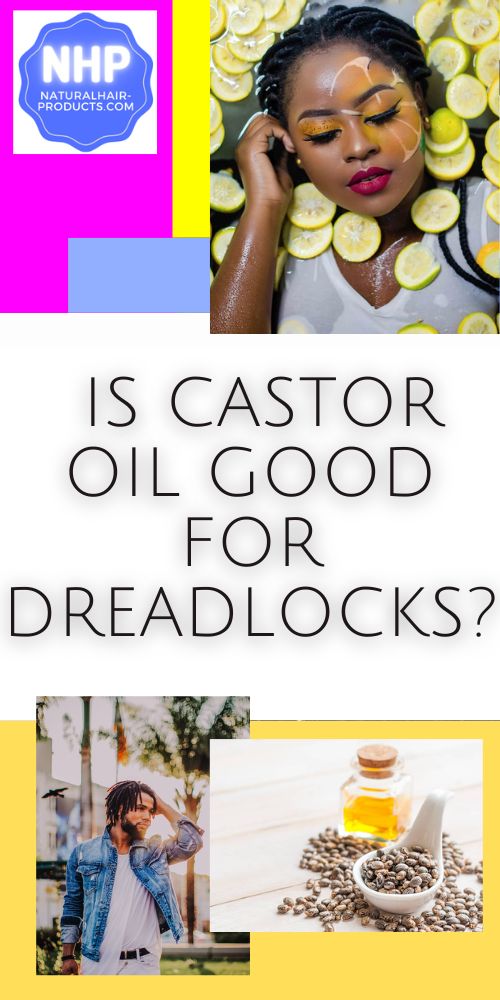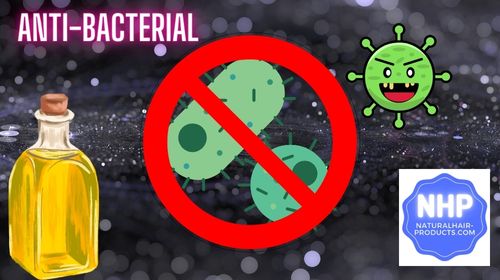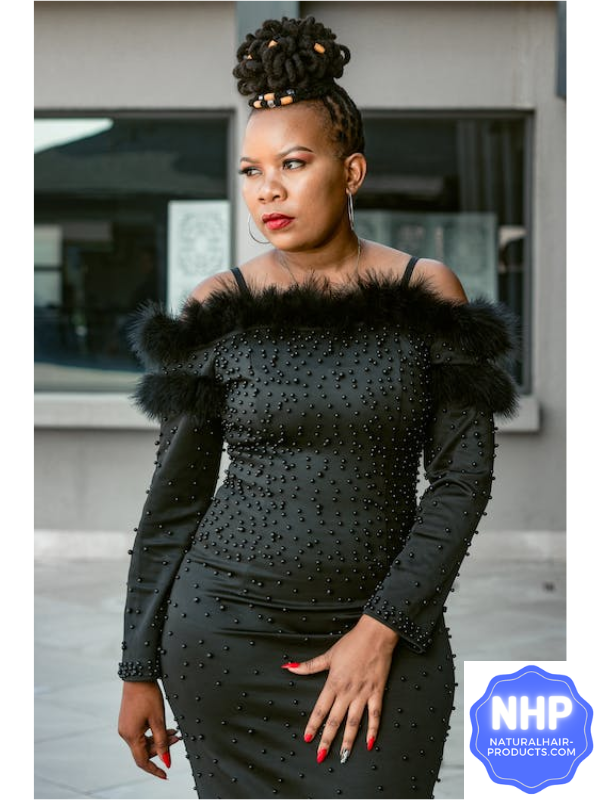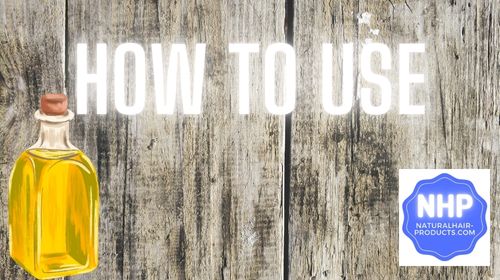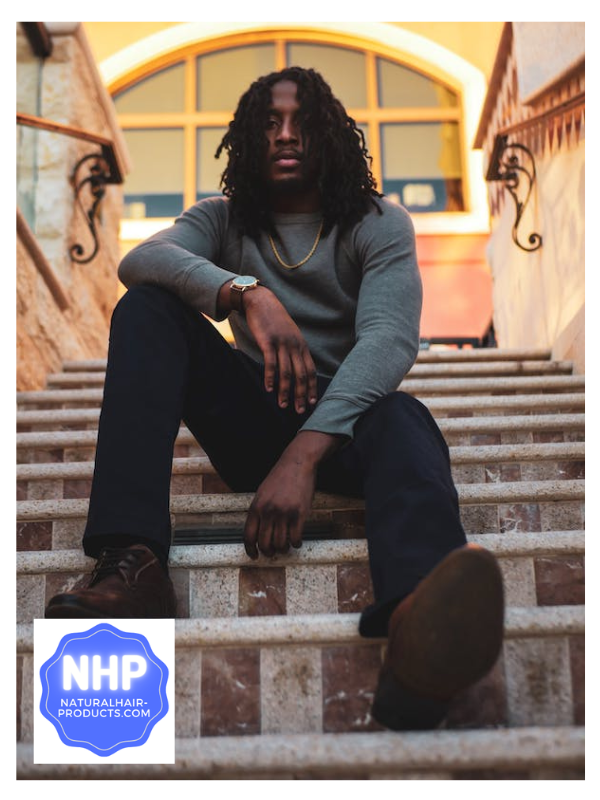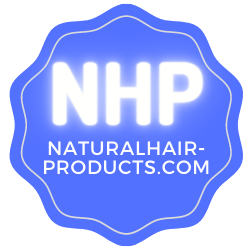Is Castor Oil Good For Dreadlocks?
- NHP
- Natural Hairstyle Ideas
- Loc Styles
- Is Castor Oil Good for Dreadlocks
Is castor oil good for dreadlocks? The answer is yes for many, yet, it depends on how you’re using castor oil or JBCO.
Some add it to hydration shampoo while some apply it directly to their scalp for edges and hair growth benefits.
Whether castor oil is good for YOUR LOCS will be determined on what goal you want to achieve and the manner in which you apply you castor oil.
As is the case with many things in life, there’s no ONE-SIZE-FITS-ALL answer.
Shoot, some loc’d ladies and fellas won’t let castor oil touch their locs ever again because they got a ton of itching from the way they used it and how their scalp responded.
So, I want YOU to decide is castor oil good for dreadlocks after you see the benefits, we also show you the bad parts of using castor oil on locs and the different ways to use JBCO (and plain castor oil) on dreadlocks.
Let’s talk about the benefits...
Why Castor Oil Is Good For Dreadlocks: The Benefits
If I ask some locs wearers if castor oil is good for dreadlocks or not, they’ll look at me crazy and say “YES FOOL! Look at my luscious locs!"
It’s because I use castor oil on them like crazy!”...
Well, these folks are obviously getting all kinds of benefits, so here’s whats great about castor oil on dreadlocks hairstyles for the folks that love it.
Nutrient-Infusion Properties Makes Castor Oil Good For Dreadlocks

Castor oil contains nutritious hair health-boosting fatty acids that make it a natural emollient that gives your scalp and dreadlocks vital nutrients and vitamins that promote hair growth, length retention and increased moisture retention levels.
It is used as a remedy for dry scalp and hair. It prevents your locs from becoming dry and brittle, which in turn stimulates hair growth, and it can be left on your hair overnight without problem.
[RELATED ARTICLE: See the pros & cons of dreadlocks...}
Castor oil also acts as a humectant for dreadlocks, this simply means it can absorb moisture from the air and preserve it.
When applied correctly, JBCO can make your locs soft, shiny, and healthy, reducing the flaking because of its wealth of health-promoting nutrients.
Anti-inflammatory, Antimicrobial, & Antifungal Properties Makes Castor Oil Good For Dreadlocks
Is castor oil good for dreadlocks when you have fungal issues on your scalp? Yes, big time.
Castor oil is also good for inflamed scalps because it contains a fatty acid called Ricinoleic acid which gives it anti-inflammatory properties.
Because of this anti-inflammatory nutrient, castor oil can be used to reduce inflammation caused by folks suffering from painful scalp conditions under their dreads.
Many of these scalp conditions cause red scaly patches on the scalp, one of the most common is known as seborrhoeic dermatitis, this irritating scalp problem causes an increase in dandruff.
Castrol oil’s antimicrobial properties protect your scalp from bacterial infections by fighting and preventing microbes’ overgrowth on dreadlocks that can cause unhealthy hair conditions.
Studies have shown that the antifungal properties of castor oil may help fight fungal infections and pathogens microorganisms that may cause hair and scalp infections that lead to hair loss.
Cleansing & Detoxifying Properties That Fight Dandruff Make Castor Oil Good For Dreadlocks
One of the reasons it’s good to know how to use castor oil for dreadlocked hair is that you get all the good and avoid the bad.
It’s ALL in how you use the oil.
Think about a sharp knife and the different ways I could use it. I could use it to cut a delicious steak and enjoy a great meal OR I could use it to cut some fool for talkin’ slick.
You get the point? (I’m a peaceful person BTW… I don’t cut fools, I only smack em, LOL!)
With castor oil, you could use it to HEAL dandruff when used right, and if used wrong you might cause itchiness, irritation and only make your dandruff more of a problem.
Yet, in general, castor oil is good for dandruff treatment on dreadlocks. Even though there are so many causes of dandruff in your dreadlocks, castor oil can treat scalp conditions such as dandruff and infections.
Why?
One reason why, is that castor oil for dreadlocks is a non-comedogenic oil, which means it does not block or clog the pores, so it facilitates healing after the cleansing of the scalp.
The oil does not give much room for impurities or infections to grow on a freshly cleansed (you should first remove all dead scalp skin, dirt, and dry flakes that clog the hair roots).
Is Castor Oil Good For Dreadlock? Yes, For Beautify & Guarding Moisture In Locs
When used correctly, castor oil is good for dreadlocks moisture retention and overall beauty? The answer is a BIG YES!
Castor oil gives your dreadlocks the beautifully juicy and moist look that you need in ya life. JBCO (as well as normal castor oil) acts as a lubricant, coating, and conditioning the loc’d strands, improving smoothness, softness, and shine.
Using castor oil helps your locs grow more robust, thicker, and shinier. It is a remedy for increasing healthy, beautiful, shiny locs.
Castor Oil Is Good For Healing Dry & Damaged Dreadlock Hair
Castor oil is also good for dreadlocks when attempting to prevent hair loss and to repair damaged hair. JBCO’s moisturizing and healing properties come in handy to ensure your locs are strong, maintained, and healthy to ensure no hair loss.
Applying castor oil to your dreadlocks helps to lubricate the locs shaft, treating the damages caused by color treatment, and decreasing the chance of hair breakage and loss in the future.
Or, at least slowing the rate of hair loss on the scalp and edge.
Castor Is Good For Stimulating Hair Growth In Dreads
For your dreadlocks to grow fast, they have to be situated in a healthy “growth terrain” (i.e. scalp) environment that fosters and stimulates growth in hair length and volume.
Castor oil creates a healthy growth environment for your dreadlocks because of the breathability it gives your scalp and the nutrient-infusion it provides.
JBCO is especially recommended for starter locs that need consistent growth retention and maintenance care.
Although unscented castor oil smells unpleasant, it may be worth the stink if you have very short or starter locs.
You have to use it consistently for maximum results in hair growth. When massaged on the scalp, the oil massage improves the blood flow, which also stimulates hair growth.
Also, don’t worry about the smell, you can find castor oil brands for dreadlocks that smell amazing or add other heavenly-smelling products like rose water on your locs.
JBCO Is a Great Carrier Oil for Dreads
Among all its benefits, we must not forget that castor oil is an ideal carrier oil for your collection of essential oils. Essentials are concentrated and sometimes toxic in too high of a dosage.
That’s why many super-strong essential oil cause severe skin irritation when used on their own without a good carrier.
A good carrier oil like castor oil can be used to dilute and make essential oils like peppermint oil tea tree oil less harsh on for skin and hair.
For better results in the health of your dreadlocks, add the essential oil of your choice and enjoy the nourishing benefit.
Good Castor Oil Products For Dreadlocks
Here are some of the best castor oil products that work well on locs, take a look...
- PURA D'OR Organic Castor Oil
- OKAY | 100% Pure Black Haitian Castor Oil
- Non-GMO Home Health Original Castor Oil
- Jamaican Mango & Lime Black Castor Oil Rosemary
- Jamaican Mango & Lime, Black Castor Oil, Lavender
How To Use Castor Oil For Dreadlocks Hair:
There are a ton of ways to apply castor oil to your dreadlocks.
Before we get to those ways, let me tell you what NOT TO DO because it could instantly cause a lot of problems for your dreadlocks and scalp.
Make sure NOT to lay castor on too thick and don’t leave it on for long periods of time if your hair and scalp haven’t been cleansed first.
OK, so about how to properly use castor oil for dreadlocks:
Some people like to leave it on their locs overnight, while others like to massage it into their scalp. The best method for you totally depends on your hair type and concerns.
As a reminder, Jamaican black castor oil is on the thicker side, so it’s best for anyone with dense or coarse hair, whereas regular cold-pressed castor oil is great for finer hair types.
How to use castor oil for a scalp treatment:
Using castor oil for a scalp massage is perfect, but don’t forget the ends too.
Thoroughly work your castor oil product of choice throughout the dreadlocks and loose strands as well as the scalp for 5 to 10 minutes.
You could also try sitting under a hair steamer for 20 to 30 minutes to help the castor oil or JBCO really penetrate your scalp, and then keep it in until your next wash day.
How to use castor oil for a moisturizing dreadlock pre-’poo treatment:
For the best results, mix premium castor oils for dreads with other growth-boosting carrier oils, such as jojoba or coconut oil.
They weaker carriers can also help to dilute it.
Some loc’d ladies and men love mixing castor oil with olive oil (another carrier oil) as a hair treatment for dreadlocks, and this combo works great for an intensely moisturizing pre-’poo on dry hair.
You could also try mixing a few drops of castor oil into your conditioner and spreading it through damp hair for at least 30 minutes before washing.
How to use castor oil on dreadlocks for overnight deep conditioning:
Is castor oil good for dreadlocks conditioning treatments? Yes, you better believe it. Just coat your dreadlocks with castor oil and slap on a shower cap before going to bed.
When you wake up, follow with a premium shampoo and conditioner. Note: Some people opt for a double shampoo to help rinse the castor oil all the way out. And hey, if you aren't sure how often to cleanse you locs, check out our tutorial titled: "How often should you wash your dreadlocks?"....
How to use castor oil for dreadlocks growth:
Combine castor oil with olive, grape-seed, coconut,
The aim is to create a healthy environment for hair growth and prevent hair loss and breakage.
To achieve this, your castor oil can be mixed with any of these hair growth oil:
- coconut oil
- olive oil
- grape-seed oil
- rosemary essential oil
- vitamin E
Mix your desired amount of each oil in an applicator bottle for a gentle and antioxidant-rich scalp treatment. These oils are well known for natural hair growth boosting.
Apply it on your scalp and hair before washing. Leave it for at least an hour's time to penetrate the scalp, hair follicles, and hair shaft.
Castor oil thickness makes it difficult to effectively apply on your scalp and locs because it might leave residuals that will be difficult to wash out. Mixing it with a lighter oil like coconut is recommended to make sure it absorbs into your scalp properly without leaving unwanted residuals.
Use the castor oil on your dreads in small amounts. Due to its thickness, you do not want to load it on your hair and scalp. Ideally, 1 teaspoon is enough, and then add a few drops of your essential oil.
For those dealing with scalp balding, hairline loss, and thinning, apply castor oil on the affected areas and on the edges of your scalp.
Be sure to have in mind that the best method for using this oil totally depends on your hair type and concerns.
The Bad Side Of Castor Oil For Dreadlocks
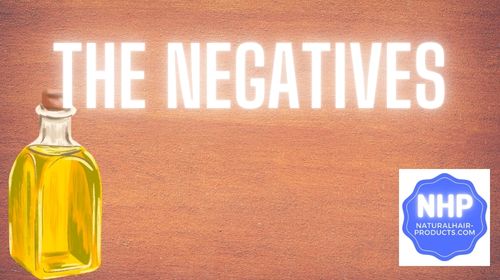
Is castor oil good for EVERYONE who has dreadlocks? No, it’s not. Because castor oil is a strong oil some folks find that it irritates their scalp.
Others can't get past how thick it is and use too much which causes their dreadlocks to get weighed down and even blocks the hair follicles from letting water and moisture enter.
Another thing about pure and unscented castor oil is that it smells bad and nobody wants stinky locs. So, at the end of the day there is a good side and bad side to castor oil for dreadlocks.
How to Take Precautions Castor Oil For Dreadlocks
There are a few precautions you need to take when using castor oil for your dreadlocks. These include:
Do a patch test on dreadlocks before applying:
Castor oil for hair is used in different ways by many people. It is not for everyone though. It is recommended, just like any other skin product, to do a patch test with castor oil before applying it to your scalp.
You can apply a small amount behind your ear to test if the castor oil works well with your scalp.
Mix castor oil with an another carrier oil:
Castor oil costs hair like crazy due to its thickness. If applied directly on your scalp or locs, it might get stuck for days and will be challenging to clean out the residue.
This means it can also block or clog your scalp pores and follicles. It is therefore recommended to combine castor oil for dreadlocks with active essential oils or lighter carrier oils.
Side effects of castor oil when used on dreadlocks:
Castor oil on dreadlocks is relatively safe; however, skin irritation and rashes on the skin are common side effects. If you experience these allergic reactions, you should not continue using castor oil.
Note that applying the oil straight to your scalp may also lead to these side effects.
The side effects include:
- Skin irritation and itching
- Inflammation
- Dryness
- Skin rashes
If you experience these allergic reactions after applying castor oil to your dreadlocks and scalp, discontinue use immediately and seek a trichologist or dermatologist if the problems continue.
Acute Hair Felting With Castor Oil For Dreads:
Acute hair felting is a rare condition that causes your hair to entangle into a hard mass and has no remedy, and in most cases, you’ll have to end up cutting your dreads or the affected areas of your hair. If you run into this major issue, you should obviously avoid using castor oil on your dreads in large amounts.
It may be best to leave it alone entirely and use other oils on your locs.
Castor oil from your locs can stain your clothes:
While applying castor oil to dreadlocks, if it falls on your clothes or towels, it may stain. It is therefore recommended that you use an old t-shirt when applying castor oil on your dreads. Wash off the oil properly before drying it with your clean towel.
Other side effects of applying or consuming large amounts of castor oil include abdominal cramps, dizziness, nausea, diarrhea, hallucinations, throat tightness, shortness of breath and chest, and fainting.
Avoid taking castor oil if you are pregnant, it can induce premature labor.
Conclusion: Castor Oil For Dreadlocks Is Good or Bad Depending On You Variables
It’s a good thing to note the various cases of anecdotal proof about growing hair, and hairline edges with castor oil.
Yet, it’s only fair to note that there is no HARD scientific evidence of castor oil stimulating hair growth. However, people have reported experiencing hair growth after using castor oil like crazy in videos and articles across social media.
To determine the full benefits of castor oil, we will need more scientific research.
The popular oil is purchased by people experiencing dryness in their scalp, hair balding, and hair loss—those who have brittle hair experiencing breakage and thinning.
Still, castor oil for dreadlocks isn’t a silver bullet sure-fire remedy.
If you pay attention to how to properly use it, not only is castor oil good for dreadlocks but many other natural hairstyles and hair growth journeys.
Yet, if used incorrectly, castor oil can possibly make a bad situation worse. Please, use it on a clean scalp and be sure to not lay it on too thick if leaving it in without rinsing it out.
As you will see on our Pinterest "locs product" board, there are alternative oils and dreadlock product for you to use.
Missed Something? Jump Back Up The "Is Castor Oil Good For Dreadlocks?" Tutorial! Go Back To:
- TOP OF PAGE: Is Castor Oil Good For Dreadlocks?
- Is Castor Oil Good For Dreadlocks? Yes, The Benefits.
- Is Castor Oil Good For Dreadlocks? No, The Drawbacks.
Follow Author of "Is Castor Oil Good For Dreadlocks?" Article...
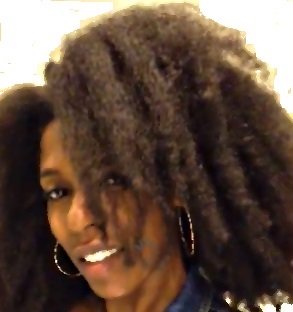
ABOUT THE AUTHOR: Melissa Lee
Melissa Lee is a Contributing Editor to NHP and a former owner of the BlackhairOMG website. She formed 4C Trichology Growth Services, LLC., a US based hair care consultation service. She has also contributed as a writer and consultant for various hair and beauty websites. Melissa can be followed on Twitter here.
